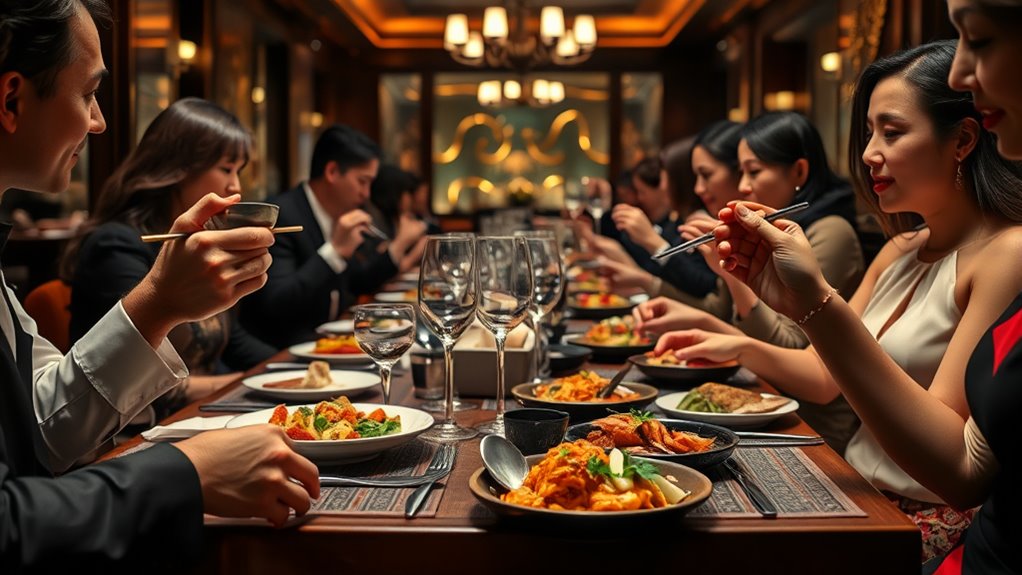When dining abroad, respect local menu styles by observing how dishes are presented, shared, and ordered, and follow regional customs for serving and etiquette. Pay attention to gestures, seating arrangements, and dress codes to show respect. Communicate dietary needs clearly and politely. Be aware of tipping norms and table manners to avoid misunderstandings. By embracing these differences, you’ll enjoy a richer cultural experience; exploring further will help you master these essential skills.
Key Takeaways
- Observe local menu symbols, presentation styles, and serving customs to understand cultural values and appropriate dining behaviors.
- Respect hierarchy and seating arrangements, serving order, and communal or individual dining practices.
- Use utensils correctly and follow course progression to align with regional etiquette norms.
- Communicate dietary needs clearly and politely, considering language and cultural differences.
- Show respect and engagement through polite gestures, facial expressions, and appreciation of local food presentation.
Recognizing Cultural Differences in Menu Presentation

Understanding cultural differences in menu presentation is essential when dining abroad, as it reveals underlying values and traditions. Menu symbolism guides how dishes are arranged and decorated, reflecting deeper meanings—like red in Chinese cuisine symbolizing good fortune or Indian patterns expressing hospitality. Food aesthetics emphasize harmony, balance, and seasonal beauty, especially in Japanese cuisine, where minimalism and natural presentation evoke serenity. Middle Eastern and African menus often showcase vibrant colors and layered textures on communal platters, highlighting generosity and social bonds. European plating favors precision and simplicity, emphasizing individual artistry. Recognizing these differences helps you appreciate the cultural significance behind each presentation style, enhancing your dining experience and showing respect for local traditions. Cultural symbolism in food presentation can also influence diners’ perceptions of quality and authenticity. Understanding these nuances enriches your awareness of global culinary diversity and fosters a deeper respect for culinary traditions.
Understanding Local Ordering Customs and Gestures
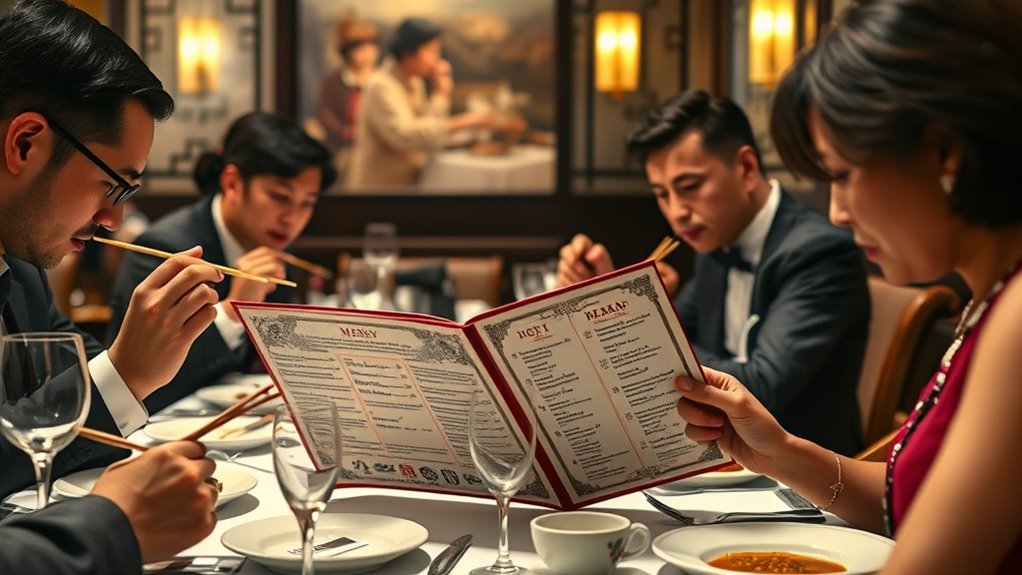
When dining abroad, being aware of local ordering customs and gestures can greatly enhance your experience and show respect for cultural traditions. Many cultures favor a seasonal menu, emphasizing fresh, locally sourced ingredients, so try to choose dishes that reflect the current season. Be mindful of dietary restrictions; in some places, asking for modifications might be seen as impolite, so observe how others order and follow suit. In communal dining settings, orders are often placed collectively to ensure everyone shares, and pacing may follow hierarchy or age, with elders ordering first. Gestures like offering food first or performing ritual hand washing highlight hospitality. Respect these customs to foster goodwill and deepen your appreciation of the local dining culture. Understanding local customs can also help you navigate tipping practices and appropriate dress codes, ensuring a respectful and enjoyable dining experience. Additionally, being aware of the characteristics of a healthy breakfast can inspire you to incorporate nutritious choices into your meals abroad, promoting well-being during your travels.
Adapting to Serving Styles and Meal Progression

When dining abroad, it’s important to recognize regional serving customs and follow the typical meal course order. Respect the local hierarchy by observing who is served or starts eating first, as it shows appreciation for cultural norms. Adapting to these styles helps you navigate meals smoothly and demonstrates your respect for local traditions. Additionally, being aware of the common dining customs in each country can prevent misunderstandings and ensure a more enjoyable experience. Paying attention to wall organization systems can also aid in understanding how space and order are valued in different cultures, enhancing your cultural awareness.
Recognize Regional Serving Customs
Recognizing regional serving customs is essential for adapting to different dining styles and meal progression. Observing regional food presentation helps you understand how dishes are shared or plated, such as Asian communal serving or Moroccan low tables with bread used as cutlery. Traditional dish symbolism influences the order and manner of serving, like Chinese dishes representing prosperity or longevity, or Middle Eastern offerings emphasizing hospitality. In some cultures, meals are served family-style for everyone to share, while others focus on individual portions. Being aware of these customs allows you to respect local etiquette and participate appropriately. For example, in Russia, offering vodka in abundance signals friendship, and in Spain, tapas encourage sampling multiple dishes. Recognizing these serving customs ensures you navigate dining experiences respectfully and confidently, especially considering that regional presentation styles can vary significantly across cultures. Additionally, understanding the types of serving utensils used in different regions can help prevent unintentional breaches of etiquette.
Follow Meal Course Norms
Following proper meal course norms is essential for steering dining experiences smoothly and respectfully. Pay attention to the table setting, especially the arrangement of utensils, which guide you through the dish presentation. Typically, courses are served sequentially, and each is cleared before the next appears, keeping the table organized. Use utensils from the outside in, following the serving order. Be mindful of pacing, taking time to enjoy each dish without rushing. Observe the host’s cues and follow their lead on when to start or pause. Respect the progression of courses, ensuring you handle each with proper etiquette. Clear table settings between courses and maintain good posture. Understanding the typical sequence of courses helps you anticipate what’s coming next. Additionally, being aware of the role of contrast ratios and color accuracy in visual presentation can enhance your appreciation of each dish’s appearance and presentation. By adhering to these norms, you demonstrate cultural awareness and contribute to a pleasant dining atmosphere.
Respect Dining Hierarchies
Understanding and respecting dining hierarchies is essential for maneuvering formal and cultural meals smoothly. It helps you navigate silent dining cues, table placement, and serving order without causing offense. In many cultures, the seating arrangement reflects social status or age, making it crucial to observe and adapt accordingly. 1. Observe who sits at the head or is served first—eldest or highest-ranking guests always take precedence. 2. Follow cultural norms, such as communal dishes or ritual sequences, to show respect. 3. Be attentive to serving progression, offering or accepting food at appropriate moments. 4. Use utensils properly, matching the style and hierarchy—such as continental dining—indicating discipline. Additionally, understanding dining etiquette in different settings can facilitate smoother interactions and demonstrate cultural sensitivity.
Navigating Special Dietary Requests Respectfully
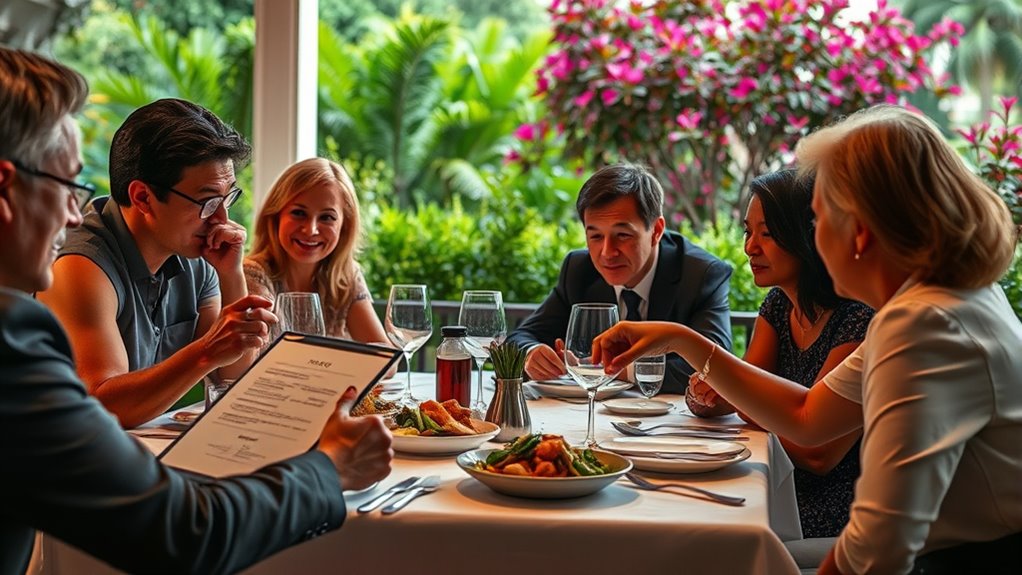
Managing special dietary requests abroad requires clear communication and cultural sensitivity to guarantee guests feel respected and well cared for. Start by informing restaurants about dietary needs in advance, emphasizing any gluten free awareness or specific restrictions. Many menus now include vegan labeling, making it easier to identify suitable options. When ordering, clearly specify your requirements and ask staff to confirm they understand, especially if language barriers exist. Be aware that cultural variations may influence how dietary requests are handled; in some regions, restaurant staff may be more accustomed to accommodating certain needs. Always review menus beforehand if possible, and politely reiterate your needs during service. Proper communication can prevent misunderstandings and ensure staff are prepared. Being knowledgeable about local customs and practices can also help in navigating cultural differences effectively. Respectful communication ensures your dietary restrictions are met without misunderstanding, fostering a positive dining experience abroad.
Observing Etiquette in Menu Signaling and Readiness

Observing proper etiquette when signaling your readiness to order or indicating meal progress is essential for a smooth dining experience abroad. Understanding menu cues and signal gestures helps you communicate respectfully with staff. Using appropriate signals, such as subtle gestures or noting the presence of a cozy textiles, can improve your dining experience. 1. Use a closed menu on the table to show you’re ready to order; avoid waving or raising your voice. 2. Maintain eye contact or gently raise your hand to signal your readiness without being disruptive. 3. Place utensils side by side at 4 o’clock on your plate when finished eating; crossing utensils indicates you’re still eating. 4. Pay attention to local cues, such as gestures or table signals, as customs vary by culture.
Proper Use of Cutlery and Chopsticks Across Cultures
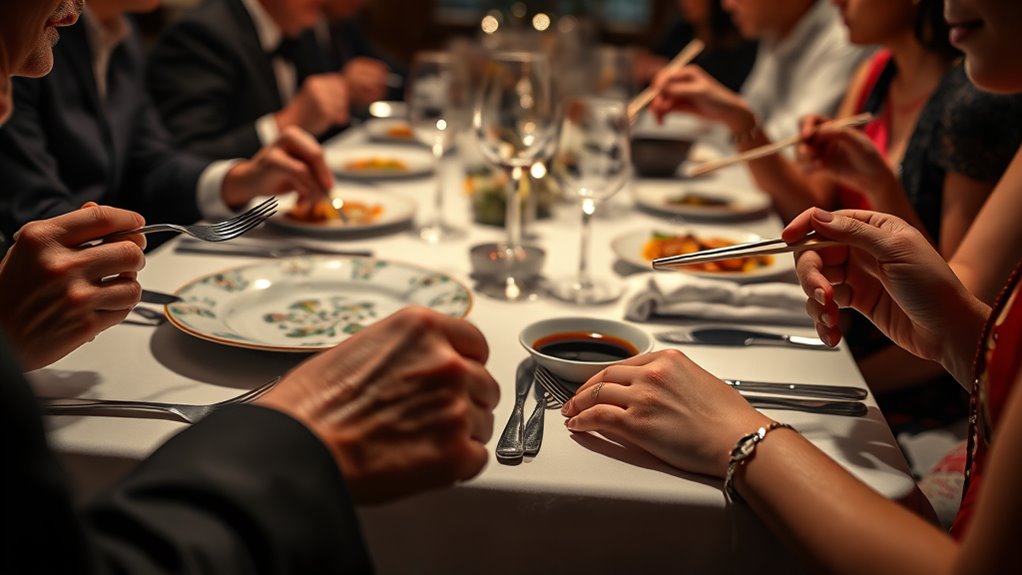
When using cutlery and chopsticks abroad, you’ll notice that proper handling and cultural variations are key to respectful dining. In some cultures, like Japan, specific rules govern chopstick use, while in others, the placement of utensils signals meal progress. Understanding these differences helps you navigate international tables with confidence and respect. Additionally, being aware of cultural dining customs can enhance your dining experience and show appreciation for local traditions.
Proper Chopstick Handling
Using chopsticks properly is essential to show respect for local customs and demonstrate good manners across different cultures. Proper chopstick posture reflects your upbringing and cultural awareness, while incorrect use can offend. To master proper handling, keep these principles in mind:
- Maintain a relaxed grip, avoiding stabbing or excessive force.
- Never stick chopsticks vertically into rice—this mimics funeral incense sticks and symbolizes death.
- Use the top chopstick for precise movements, and avoid tapping or knocking against bowls to prevent appearing rude.
- Be mindful of cultural symbolism; for example, in China and Vietnam, lifting rice bowls close to the mouth is appropriate, but never wave or gesture with chopsticks.
- Understanding cultural etiquette can help you avoid unintentional disrespect and enrich your dining experience.
Mastering these techniques shows respect and cultural sensitivity, making your dining experience more meaningful.
Cutlery Etiquette Variations
Cutlery etiquette varies considerably across cultures, influencing how you handle knives, forks, and spoons during a meal. Your table setting and utensil placement reveal much about local manners. In Western traditions, utensils are arranged outside to inside, with forks on the left and knives and spoons on the right. European styles often keep the fork in the left hand and knife in the right throughout the meal, with tines facing down. In contrast, American habits may involve switching hands or using utensils more casually. Cultural differences extend to how you rest or position cutlery—placing utensils parallel signals completion, while improper angles or pushing food with fingers can be seen as rude. Being aware of these variations helps you navigate international dining with confidence and respect.
Respecting Dining Rituals and Table Seating Arrangements
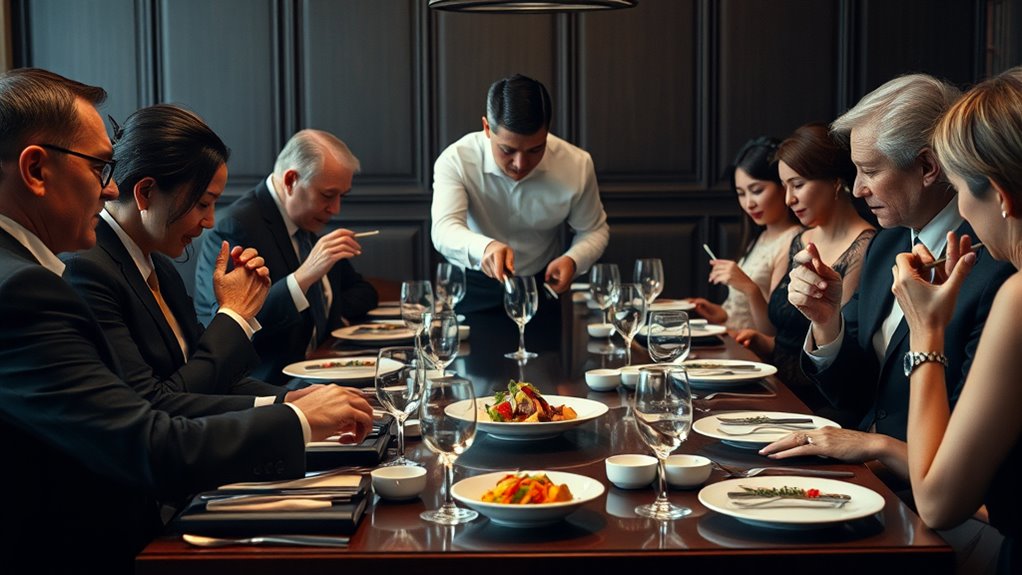
Respecting dining rituals and table seating arrangements shows your awareness of local customs and helps foster harmony at the table. Pay attention to how seating is organized, as it often reflects social hierarchy, age, or relationships. Observe the host’s guidance before taking your seat, especially in formal settings. Using appropriate tableware and utensils is also crucial, as different cultures have specific etiquette for handling them. Unique and Wicked Planters can serve as conversational pieces that demonstrate cultural awareness and interest in local crafts.
Appropriate Dress and Punctuality Expectations

Understanding appropriate dress and punctuality expectations is essential when dining abroad, as these norms vary widely across cultures. Dress code enforcement varies—fine dining often requires formal attire, like suits and dresses, while some regions, such as the Middle East, emphasize modesty with suits and ties. Checking the restaurant’s website or calling ahead helps clarify dress expectations, especially since casual dress codes in upscale settings still demand polished looks. Punctual arrival is equally important; arriving on time shows respect for staff, chefs, and fellow diners, and helps ensure smooth service. Different cultures view punctuality differently—European countries value strict punctuality, while others may be more relaxed. Being aware of these differences enables you to dress appropriately and arrive promptly, respecting local dining norms. Additionally, understanding local customs around cultural etiquette can significantly enhance your dining experience.
Tipping Practices and Payment Norms Worldwide
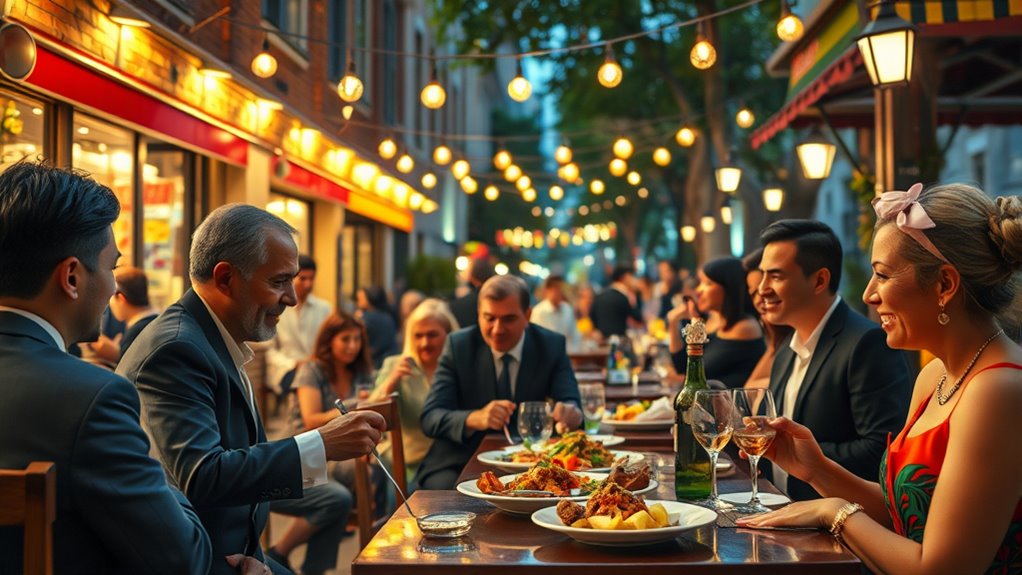
Tipping practices and payment norms vary widely across the globe, reflecting different cultural expectations and economic conditions. As you navigate international dining, understanding tipping etiquette and payment methods helps avoid awkward moments.
- In countries like Argentina and South Africa, cash tips are common, often 10-20%, especially when service charges aren’t included.
- In places like Australia and Spain, tipping is modest or optional, with small tips or spare change appreciated.
- Payment methods differ: credit cards are widely accepted, but cash tips may be necessary in some regions. Mobile payments are gaining popularity in countries like China.
- Remember, in South Korea, tipping is unnecessary and can be rude, so always research local customs beforehand.
- Being aware of service charge policies can further ensure respectful interactions and prevent confusion over gratuities.
Engaging Respectfully During Food Sharing and Social Interactions
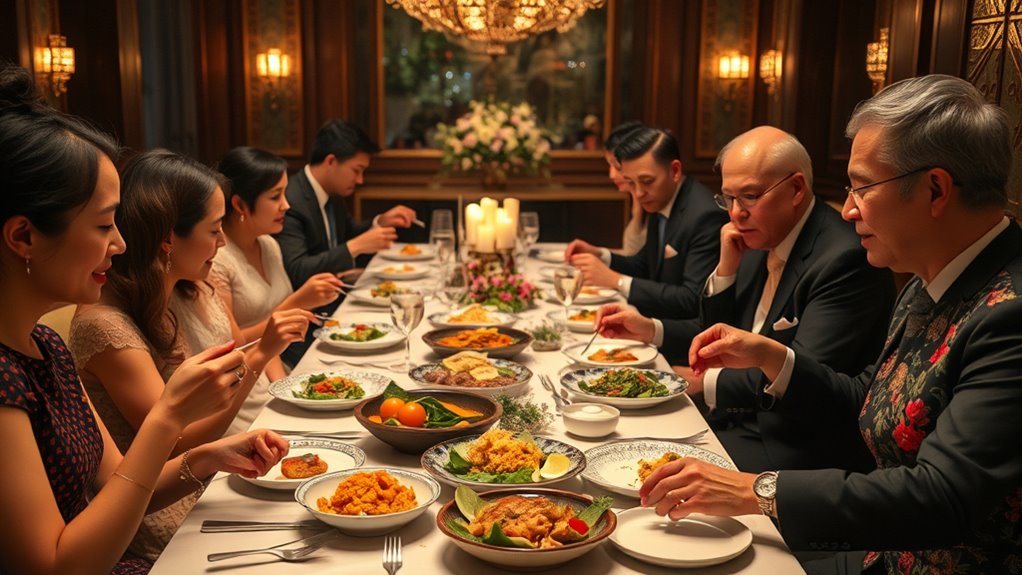
When sharing food abroad, it’s important to respect local customs and understand how communal eating works in that culture. Use appropriate gestures and follow the lead of your hosts to show genuine interest and respect. Engaging with curiosity and kindness helps foster meaningful social bonds during shared meals. Being aware of local dining etiquette can help you avoid misunderstandings and demonstrate your appreciation for the host’s traditions.
Respect Cultural Sharing Norms
Respecting cultural sharing norms is essential for engaging politely during food exchanges and social interactions abroad. You should be aware that food sharing often embodies cultural storytelling and food symbolism, revealing values and traditions. To do so respectfully:
- Observe how hosts present and serve food, recognizing rituals and symbolic gestures.
- Participate in shared meals without interrupting or criticizing, honoring the host’s effort.
- Avoid discussing topics that may be taboo or sensitive, respecting unspoken rules.
- Show gratitude and appreciation, acknowledging the cultural significance behind the meal.
Use Appropriate Gestures
Using appropriate gestures during food sharing and social interactions shows respect for local customs and enhances your experience abroad. Hand gestures like offering food with a smile or accepting graciously demonstrate hospitality and humility. Facial expressions, such as nodding or smiling, can reinforce politeness and friendliness. Remember, in some cultures, gestures like placing morsels into another’s mouth symbolize respect, while in others, loud slurping or burping may show appreciation. Avoid inappropriate gestures like licking fingers where it’s considered rude or asking for salt in a way that might offend. Being aware of these cues helps you navigate social dynamics smoothly. Recognizing cultural differences in gestures can prevent misunderstandings and foster positive interactions.
Engage With Genuine Interest
Engaging with genuine interest during food sharing and social interactions shows your respect for local customs and helps build meaningful connections. Pay attention to food presentation, as it often reflects cultural values and invites participation. When menus are customizable, ask about options to show curiosity and appreciation for local flavors. To deepen your engagement, consider these points:
- Observe how dishes are shared, respecting communal eating styles.
- Compliment the chef or host on the food’s presentation or flavor.
- Participate in menu customization, signaling openness and respect.
- Use appropriate gestures to acknowledge the importance of the shared meal.
- Familiarize yourself with table manners, which can vary significantly across cultures and demonstrate your respect for local dining etiquette.
Frequently Asked Questions
How Do I Handle Language Barriers When Ordering Food Abroad?
When ordering food abroad, you can manage language barriers by using menu translation apps on your phone, which translate menus instantly. Gesturing techniques, like pointing to pictures or specific dishes, also help communicate your order clearly. Combining these methods ensures you understand the menu and convey your preferences effectively, making your dining experience smoother and more enjoyable without awkward misunderstandings.
What Should I Do if I’M Unsure About Local Dining Customs?
When you’re unsure about local dining customs, you should observe and follow the cues from locals, as this helps you respect cultural sensitivities. Don’t hesitate to ask your host or server for guidance—they’ll appreciate your effort to learn. Stay open-minded and patient, and try to participate in customs and traditions. Remember, embracing new dining customs shows your respect and willingness to immerse yourself in the culture.
Are There Universal Rules for Tipping in International Restaurants?
When it comes to tipping in international restaurants, there are no strict universal rules because of cultural differences and varying tipping customs. You should research the country’s practices beforehand, as some places include service charges or discourage tipping altogether. In general, a tip of 10-20% works in many Western countries, but always adapt based on local customs to show respect and avoid misunderstandings.
How Can I Politely Decline Food or Drinks I Don’T Want?
Remember, “you catch more flies with honey than vinegar.” When declining menu preferences, be polite and gentle. Use body language, like a small shake of the head or a smile, and offer a simple excuse such as dietary restrictions or fullness. Accept a tiny portion as a gesture of respect. Soft phrases like “I appreciate, but I must decline” help guarantee your polite refusals are understood and appreciated.
What Are the Appropriate Ways to Show Appreciation to Hosts During Meals?
To show appreciation to your hosts during meals, use complimentary gestures like praising the food and hospitality sincerely. You can also offer a small gift, such as flowers or wine, as a thoughtful token of gratitude. Additionally, expressing thanks verbally, making eye contact, and participating in rituals like toasts or helping with meal cleanup demonstrate your respect and appreciation, strengthening your relationship with the host.
Conclusion
By mastering manners, menus, and moments, you’ll move smoothly through multicultural meals. Embrace essential etiquette, engage with enthusiasm, and exhibit respectful gestures. Remember, cultural customs can vary vastly, but your willingness to learn and adapt makes every dining experience delightful. With a little awareness and a genuine attitude, you’ll navigate nuances naturally, nourishing not just your appetite but also your appreciation for diverse dining traditions. Savor every shared story, smile, and sip!
